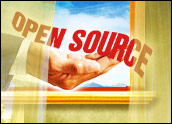
Local, state, and federal government agencies across the U.S. share the common goal of serving the public. They also share another contemporary fact of life: They are running out of money. As a result, efficiency is becoming a major goal in government at all levels, and information technology appears to be a key target for getting more bang for the buck.
That’s why innovations such as the use of mobile devices and applications, or exploring greater use of cloud technology, appeal to government agencies. And that’s also why federal agencies are gravitating more toward the use of open source technology.
It’s not that open source is the “next big thing” to come down the pike and take over IT at the federal level. However, there appears to be a greater meeting of the minds on the part of federal IT managers and open source providers that the benefits of the technology warrant more attention.
Greater adoption of open source at the federal level is likely to be an evolutionary, rather than revolutionary, process that is based on pragmatic considerations, said John M. Weathersby, Jr., executive director of the Open Source Software Institute.
Process and Products Combined
“‘Open source’ is a very broad term, and, it can be what you need it to be,” Weathersby told LinuxInsider. “It is not a product, but a development model. Like the cloud, it offers unique benefits, but it is nearly impossible to say ‘here’s exactly what it is,’ as it is more subjective and dynamic than that.”
To some degree, open source technology is best defined by what it is not, rather than what it is. Open source is not a commercially proprietary single product or line of products offered to customers through an exclusive protected arrangement.
“Open source, in a nutshell, can be described as any software product that is licensed so that it can be freely modified and distributed in hopes that others will adopt the software and improve upon it by adding functionality or correcting mistakes and then distributing the enhanced product to still others,” Weathersby said.
Nor is the technology new, considering the history of Linux and of the components of the Internet itself.
“Open source has become mainstream. It is has assumed an essential role within industry, government and the independent IT fabric which we rely on daily,” added Weathersby.
If open source is not new and is not a single “silver bullet” product that can radically solve IT problems at one pass, what is it that makes the technology attractive now to federal agencies?
Technology Equals Proprietary Offerings
“One of the benefits is that open source offerings are as good or better than proprietary technologies in terms of functionality and they are less expensive,” suggested Sam Friedman, business intelligence practice manager for Column Technologies.
“They have good ‘out of the box’ capability and most open source packages don’t require a lot of up-front investment,” he told LinuxInsider. “In fact, I was in the United Kingdom recently, and they are making strong efforts there to move to open source simply because of tighter government budgets.”
Friedman recently advised the U.S. Marine Corps (USMC) at Camp Lejeune, N.C., on an IT installation that eventually led to the use of an open source offering. The Marines replaced SAP Crystal Reports with Jaspersoft , an alternative business intelligence suite that deals with monitoring, managing and maintaining IT systems.
The main reason for the switch was the technical capability of the alternative, and the lower cost associated with an open source solution was a bonus.
Delivering browser-based reporting access in the existing platform would have involved substantial additional licensing costs, according to Jaspersoft. Also, scaling to the desired size was unnecessarily complex and, again, required expensive licensing fees. Lastly, the existing platform was incompatible with the USMC’s pre-built Web connector, which only worked when those products were deployed on a Microsoft Windows platform — not on Linux or Unix.
Customization, Security Obstacles
While vendors can point to many more case studies of successful deployments at federal agencies, it appears there has not been — and perhaps won’t be — any stampede to open source technology. The pace of adoption may quicken as a result of beneficial cost factors, but there are still other impediments to adoption.
“Our research shows there is still a large attitude of ‘wait and see’ on the part of federal agencies,” said Deniece Peterson, manager of industry analysis at INPUT.
“They are more cognizant of open source, and they are looking at some of the applications to see how they work. But many agencies don’t have the expertise to customize open source applications for their own purposes, and there is still some concern about security and reliability issues,” she told LinuxInsider.
The overwhelming reason for the adoption of open source — or any other innovation for that matter — is cost, according to INPUT.
Sixty-three percent of respondents said cost would be the primary factor for choosing an open source solution, the firm found, in a survey of government IT specialists focusing on technology adoption at the federal level.
One third of respondents were using some open source solutions, INPUT found, while another third had not even had any discussions about introducing open technology into their operations. The remaining third were at various levels of exploring open source through education or pilot trials.
In terms of obstacles to using open source, the report noted that 53 percent of respondents ranked security as the major obstacle to adoption, while 12 percent said that standards posed the biggest problem.
Whether open source is adopted through the use of commercial vendors, or developed through in-house efforts, implementation is typically accomplished through an incremental, evolutionary process, respondents indicated.
There has been no sign that attitudes have changed in the year since INPUT conducted the survey, Peterson observed.
Cost Factor Provides Opportunities
For commercial open source vendors, the increasing attention to controlling costs by federal agencies will provide a major window of opportunity to cracking the government market.
“If there’s anything federal agencies put a premium on, it’s streamlining costs,” Jaspersoft CEO Brian Gentile told LinuxInsider. “Deploying open source software generally takes less time and fewer resources than proprietary software. It’s also built on open standards, so licensing costs are exponentially less, and the public sector has the responsibility to use every tax dollar as efficiently as possible.”
Acceptance of open source is greater at the federal level than is generally acknowledged, and lower costs associated with the technology will facilitate more adoption, according to Gunnar Hellekson, chief technology strategist at Red Hat.
“Just within our company, we have experienced substantial procurement of our products from federal agencies,” Hellekson told LinuxInsider. “Concerns about open source functionality, reliability and security were largely resolved when the Department of Defense issued a procurement bulletin in October 2009 that strongly supported the consideration of open source technology.”
Still, Red Hat and others in the IT community found it worthwhile to establish an advocacy group called “Open Source for America” in July 2009. One goal of the association is “to encourage federal agencies to give equal priority to procuring free and open source software in all of their procurement decisions.”
While recognition of open source tools has reached a significant level within the federal government, “we needed a focal point for guiding federal agencies,” Hellekson said, “and to provide assistance to them on the advantages of the technology.”














































Open source in government is an illusion, I think. When a government agency procures something that is to be used by the government, there has to be a specification written to define the parameters of the item and there is always some clause used to require ongoing support for extended periods of time. Frequently the parameters for software systems call for compatibiity with existing systems or data and that tends to lock the procurement into some specific technology, for example MS Office or Windows platforms.
Where it does not, there is still the onus on the selected supplier to support and extend the software for a 10 year typical period. When the procurement is large, the size of the bidder is considered in regard to the supplier’s viability for the long term and for assurance that the supplier can deliver. So some company has to take up the banner and commit to the long term on their own and they cannot point to a liklihood that some community will step in to fill their shoes if there is any problem.
What will inevitably happen is that the cost of the support guarantee will go up as the cost of proprietary licenses go down and the government will save nothing.
Whether or not a company quotes Linux or Windows or anything else, the company has to be big enough to deliver and that reads IBM, Microsoft, Oracle, and just a few others.
very fair.
i agree that is an evolutionary process.
Open source, needs big agencies that can contribute BACK and not just free leech.
A portion of the money they save, should go back in patches and new features for improving the software.
and unlike commercial software, they can get rid of the things they DONT need, but that they want to sell to you.
anyway, i think this is an excellent start.